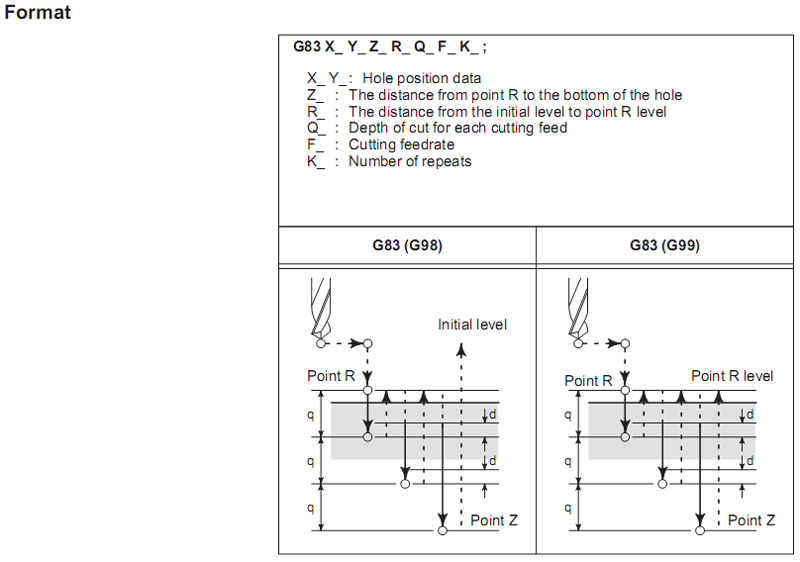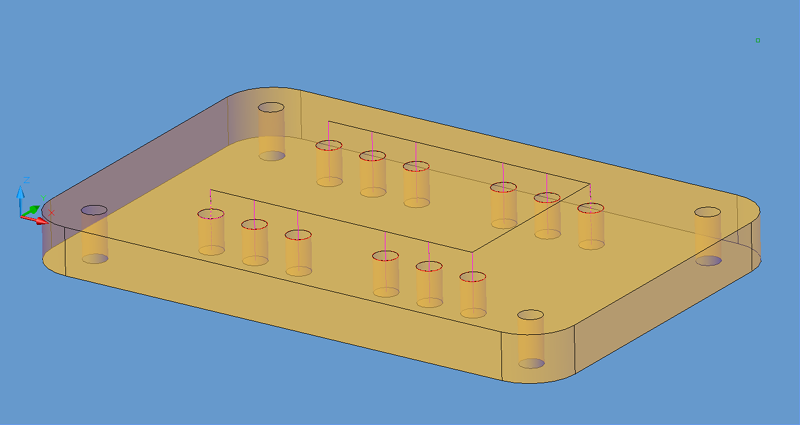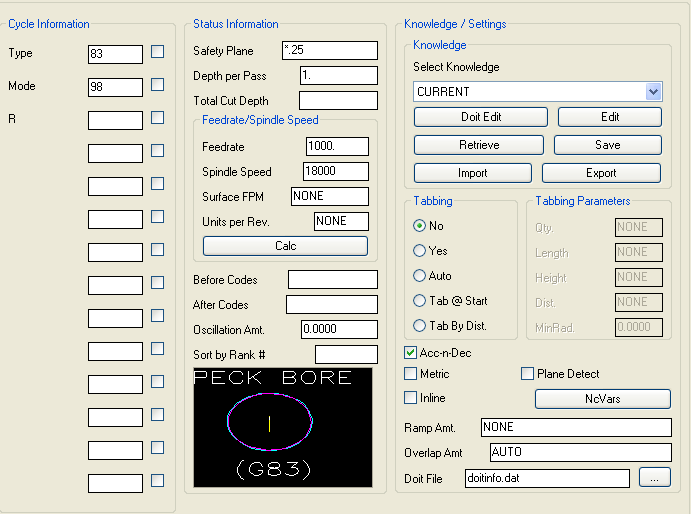|
Peck Bore is a Canned Cycle. That really means that it is a text based cycle that has several parameters which are fed to the machine controller so that all the holes chosen are cut in exactly the same manner, like a macro. In fact on most machines, Canned Cycles are an option and you should check your machine to see if it is equipped with this cycle before trying to use it. Typically, Canned Cycles are used to lessen the amount of NC Code necessary in a program when drilling a large amount of holes. There is a code savings because the Z moves up and down in each hole are not necessary. Another reason to use Canned Cycles is if you are writing code by hand, as there is less code to generate. Finally, if there is a chance that you are going to edit the code later by hand, a Canned Cycle leaves you with only one line to edit to change all the drilling parameters.
Peck Bore is typically a multiple depth per pass drilling operation. |
Canned Cycles use a series of commands on the first hole chosen and then perform those same commands on all other holes in the group. To use Canned Cycles, some explanation of them is necessary. This data is from the Fanuc control manual and will be specific to Fanuc controls or controls that can emulate the Fanuc code.

Peck Bore Cycle.

Holes drilled with Canned Cycles.

Peck Bore parameters.
The following parameters effect the toolpath creation:
Type
The type field for Canned Cycles indicated the Cycle Type or method of the canned cycle. In this case G81 is the desired Canned Cycle, so 81 is the answer in Type.
You can substitute any valid Canned Cycle type in this field to create code for another cycle type.
Mode
Mode refers to the Retract mode of the canned cycle. In the pictures above, there is either G98 Mode, where the tool retracts to the Initial Point, or G99 Mode, where the tool retracts to the location specified by the R value (the next parameter).
R
This is the absolute point where you want the tool to retract to during pecks, between holes, and when the cycle is finished.
Safety Plane
The safety plane is the location in the Z axis where the tool can retract to between cuts.
This should always be a value that places the cutter above the part to be cut as each tool change, or index move between cuts is going to start from this point.
Placing an asterisk ( * ) before the number specifies that this value is an absolute point above the part, where leaving this out determines the point to be incremental.
See the Safety Plane section for more information.
Depth Per Pass
This field allows multiple depths of Cut in a single tool path. By setting this number to a value less than the Total Depth of the Cut, you will have multiple passes in the material.
For example, if you have 1" thick material and need to take three passes to Cut through, you would set the Depth/Pass field at .4 (any number between .35 and .5 is valid) and the Total Depth at -1.0. The code generated will produce the first pass at -.4, the second at -.8 and the third pass at -1.0.
In most of the standard Router-CIM cycles the tool paths will ramp down between the Cuts.
Total Cut Depth
The Total Cut Depth is the depth you wish to Cut to, regardless of the number of passes made. It is usually put in as a negative number because Z0 is set at the top of the part. Router-CIM uses this number to calculate the Z axis moves for the Total Depth to Cut into the material. If the Depth/Pass field has a number smaller than this, Router-CIM calculates the number of passes necessary to reach this depth.
You may enable Router-CIM to calculate the depth automatically for you based on the thickness you give a part. To do this place "A" in the Total Cut Depth field, and if you have given you part thickness, Router-CIM will use that value for the Z depth. Remember to give your part negative thickness!
Also, when you give your parts negative thickness, you can use a forward slash (/) followed by a negative value (-.01 for example) in this field. Router-CIM will take the negative part thickness (-.75 for example), and the negative value following the slash and calculate the Total Cut Depth. In this case the part would be cut to -.76.
Feedrate
This field specifies the cutting maximum Feedrate in either inches per minute or millimeters per minute, depending on the mode you are programming in. See the chapter on Advanced Settings for information on how to program variable feed rates.
Spindle Speed
This field sets the spindle speed in rpm's (revolutions per minute). This is a modal field to many machine tools, so if you do not change this field for each Cut with the same spindle, you may only see the output for this setting once although you have made more than one Cut with the same spindle.
**Changing values in the cycle parameters may yield unexpected results with some settings or on some geometry. Examine the toolpath and NC Code carefully before running your machine tool if you change these default settings.